Welcome to Tunadorable's weekly AI newsletter, where we summarize his favorite articles of the week that he plans to read.
This article was written by gpt-3.5-turbo-16k on 2024-04-26.
# Mechanistic Interpretability for AI Safety -- A Review
The review explores mechanistic interpretability, an approach to understanding AI systems that aims to reverse-engineer the computational mechanisms and representations learned by neural networks. The goal is to provide a granular, causal understanding of how the models make decisions. Mechanistic interpretability is distinct from other interpretability paradigms, such as behavioral, attributional, and concept-based interpretability.
The review introduces foundational concepts and hypotheses that underpin mechanistic interpretability. Features are defined as the fundamental units of neural network representations, representing the smallest units of encoded knowledge. Neurons are the computational units of neural networks, potentially corresponding to individual features. However, neurons are often observed to be polysemantic, associated with multiple, unrelated concepts. This challenges the view of neurons as fundamental primitives and suggests the existence of superposition, where features are encoded as combinations of neurons. The superposition hypothesis argues that neural networks can represent more features than the number of neurons they possess by encoding features in almost orthogonal directions.
The review discusses different approaches to studying polysemanticity, including training models without superposition, using post-hoc analysis to find feature directions, and employing sparse autoencoders. It also presents the linear representation hypothesis, which suggests that features are represented as linear combinations of neurons in activation space. This hypothesis simplifies neural network representations and enhances their interpretability.
The implications of mechanistic interpretability are far-reaching, particularly for AI safety. Understanding the inner workings of AI systems is crucial for ensuring value alignment and preventing catastrophic outcomes as AI becomes more powerful and inscrutable. Mechanistic interpretability can provide insights into the decision-making processes of AI models, enabling validation, compliance, and trust. It can also facilitate manipulation of representations, potentially enhancing safety by upregulating certain concepts.
The review acknowledges challenges in scaling mechanistic interpretability techniques to handle complex models and behaviors. It calls for the clarification of concepts and the establishment of standards in the field. It also highlights the need for automation and comprehensive interpretation techniques. The review concludes by emphasizing the importance of mechanistic interpretability for AI safety and the need for further research and development in this area.
Overall, the review provides a comprehensive overview of mechanistic interpretability, discussing its foundational concepts, methodologies, evaluation, and relevance to AI safety. It highlights the potential of mechanistic interpretability to enhance our understanding of AI systems and mitigate risks associated with their deployment.
# DynaMMo - Dynamic Model Merging for Efficient Class Incremental Learning for Medical Images
The paper proposes a method called DynaMMo for efficient class incremental learning in medical image analysis. The goal is to enable a model to continually learn new classes without forgetting previously learned information. The authors address the computational overhead of existing dynamic models by introducing lightweight learnable modules called adapters. These adapters capture task-specific features and are merged into a unified model to minimize computational demands. The proposed DynaMMo method achieves a significant reduction in computational complexity without compromising performance.
To evaluate the effectiveness of DynaMMo, the authors conducted experiments on three publicly available datasets: CIFAR100, PATH16, and SKIN8. They compared DynaMMo with several state-of-the-art continual learning methods, including ICARL, UCIR, and PODNET. The results showed that DynaMMo consistently outperformed other methods, especially on the medical datasets. It achieved a significant reduction in computational complexity while maintaining comparable performance.
The implications of DynaMMo are significant for medical image analysis, where continual learning is crucial due to the evolving nature of medical data. By reducing computational demands, DynaMMo makes continual learning more feasible in resource-constrained settings. This can enhance the capabilities of medical diagnosis systems, allowing them to continually learn and adapt to new diseases without sacrificing performance.
One potential critique of the paper is the limited number of datasets used for evaluation. While the authors used three publicly available datasets, it would be beneficial to include more diverse medical datasets to validate the effectiveness of DynaMMo across different medical domains. Additionally, the authors could further investigate the robustness of DynaMMo by evaluating its performance under different scenarios, such as varying data distribution or imbalanced class sizes.
Overall, the proposed DynaMMo method offers an efficient and effective solution for class incremental learning in medical image analysis. It addresses the computational overhead associated with dynamic models and achieves a balance between previous and new tasks without compromising performance. The results of the experiments demonstrate the superiority of DynaMMo over existing methods and highlight its potential for improving medical diagnosis systems.
# Retrieval Head Mechanistically Explains Long-Context Factuality
This paper investigates how long-context language models retrieve relevant information from the input. The authors propose the concept of "retrieval heads," which are attention heads within the models that are responsible for copying and pasting tokens from the input to the output. The authors conduct extensive experiments across different model families, scales, and types of fine-tuning to analyze the properties of retrieval heads.
The key findings of this study are as follows:
1. Universal and Sparse: Retrieval heads are found to be present in all explored models with long-context capability. However, they only constitute a small portion (less than 5%) of all attention heads.
2. Dynamic Activation: Retrieval heads are dynamically activated depending on the specific tokens and contexts. Some heads are consistently activated regardless of the context, while others are only activated under specific conditions.
3. Intrinsic: Retrieval heads are an intrinsic property of the base model, acquired through large-scale pretraining. Subsequent model derivations, such as continue pretraining or fine-tuning, still use the same set of retrieval heads.
The influence of retrieval heads on downstream tasks is also examined. The authors demonstrate that retrieval heads are crucial for the factuality of the Needle-in-a-Haystack task. When retrieval heads are masked, the model's performance significantly drops, leading to incomplete retrieval or hallucination. In contrast, masking random non-retrieval heads has a lesser impact.
Furthermore, the study shows that retrieval heads strongly affect question-answering tasks that require information extraction from the input. However, tasks where the model generates answers based on internal knowledge are less influenced by retrieval heads.
The implications of this research are significant. It provides insights into the internal mechanism of long-context language models and highlights the importance of retrieval heads for information retrieval and factuality. The findings can guide future research in reducing hallucination, improving reasoning abilities, and compressing the key-value cache in long-context models.
One potential critique of this study is the focus on specific models and tasks, which may limit the generalizability of the findings. Additionally, the paper does not explore the underlying reasons for the presence of retrieval heads or how they are learned during pretraining.
# OpenELM - An Efficient Language Model Family with Open-source Training and Inference Framework
OpenELM is a new open-source language model (LLM) developed by Apple. It incorporates a layer-wise scaling strategy, which efficiently allocates parameters within each layer of the transformer model, resulting in improved accuracy compared to existing LLMs. OpenELM outperforms the recent open LLM, OLMo, by 2.36% while requiring 2× fewer pre-training tokens.
Unlike previous LLMs that only provide model weights and inference code, and pre-train on private datasets, Apple's release of OpenELM includes the complete framework for training and evaluation of the language model on publicly available datasets. This comprehensive release aims to empower and strengthen the open research community, facilitating investigations into data and model biases, reproducibility, and transparency.
During pre-training, OpenELM uses public datasets, including RefinedWeb, PILE, RedPajama, Dolma, and others, totaling approximately 1.8 trillion tokens. The training process involves layer-wise scaling, where the number of attention heads and the feed-forward network dimension are adjusted in each transformer layer. This non-uniform allocation of parameters allows OpenELM to better utilize the available parameter budget and achieve higher accuracies.
The performance of OpenELM is evaluated on various tasks, including standard zero-shot tasks (ARC, BoolQ, HellaSwag, PIQA, SciQ, WinoGrande) and tasks from the OpenLLM and LLM360 leaderboards. OpenELM consistently achieves high accuracy across these tasks, outperforming other publicly available LLMs that are pre-trained on comparable datasets.
In addition to pre-training, OpenELM can be further improved through instruction tuning and parameter-efficient fine-tuning (PEFT). Instruction tuning involves fine-tuning the model using a dataset of prompts, resulting in improved accuracy across different evaluation frameworks. PEFT methods, such as LoRA and DoRA, can also be applied to OpenELM, achieving comparable performance on CommonSense reasoning benchmarks.
The release of OpenELM and its comprehensive framework for training and evaluation has significant implications for the open research community. It promotes transparency, reproducibility, and the investigation of biases and risks associated with large language models. Furthermore, OpenELM demonstrates the effectiveness of layer-wise scaling in parameter allocation, leading to improved accuracy with fewer pre-training tokens.
A potential critique of OpenELM is the reliance on public datasets for pre-training, which may limit its performance compared to models pre-trained on larger, proprietary datasets. However, OpenELM's competitive accuracy and comprehensive release contribute to the advancement of open research and pave the way for future open research endeavors in the field of natural language processing.
# Clockwork Variational Autoencoders
# Adapting to time - why nature evolved a diverse set of neurons
This study investigates the role of adapting temporal parameters in neural networks, specifically axonal delays, synaptic time constants, and bursting, in addition to synaptic weights. The researchers trained networks on a series of logic problems with increasing temporal complexity and found that networks with adaptable temporal mechanisms were better able to solve these tasks compared to networks that only adapted weights. They also found that there were significant advantages to co-adapting multiple temporal mechanisms, and that adaptive temporal mechanisms provided robustness to noise in both inputs and parameters.
The researchers also compared different input-output encodings and found that the encoding scheme had a significant effect on network performance, with higher spike counts in the output leading to lower performance.
One interesting finding was that delays were crucial for solving the tasks, as networks that only adapted weights were unable to solve most problems. This suggests that delays play an important role in temporal processing and can greatly enhance a network's ability to map spatio-temporal spike patterns.
The study also showed that weights and time constants can simulate delays, and networks that co-adapted these parameters were able to solve all logic problems. This suggests that time constants share some functionality with weights and can emulate weight-based self-inhibition, leading to solutions without adapting weights.
The results of this study have implications for understanding the importance of temporal dynamics in neural computations and the diversity of neuron types found in nature. It also has potential implications for the design of neuromorphic hardware, as adaptive temporal parameters could provide robustness to noise.
One potential critique of this study is that it focused on simple logic problems and it is unclear how these findings would generalize to more complex tasks. Additionally, the study did not explore the interactions between different temporal parameters in depth, and it would be interesting to further investigate these interactions in future research.
# Genie - Generative Interactive Environments
Genie is a generative interactive environment that can generate action-controllable virtual worlds from a variety of prompts, including text, images, sketches, and real-world photos. It is trained in an unsupervised manner from unlabelled Internet videos, without the need for ground-truth action labels. At 11B parameters, Genie can be considered a foundation world model. It consists of a video tokenizer, a latent action model, and a dynamics model.
The video tokenizer converts raw video frames into discrete tokens, allowing for higher quality video generation. The latent action model infers latent actions between frames in a fully unsupervised manner, enabling controllable video generation. The dynamics model predicts the next frame based on the latent action and past frame tokens.
Genie is trained on a large dataset of Internet gaming videos, resulting in a foundation world model for 2D platformer games. It can generate diverse and high-quality trajectories in these virtual worlds. The controllability of the model is evaluated using a metric called Δ𝑡PSNR, which measures the difference in video generations when conditioned on inferred actions vs. randomly sampled actions.
Scaling experiments show that increasing both model size and batch size improves model performance. The final Genie model is trained with 10.7B parameters on 942B tokens, achieving high-quality video generation.
Qualitative results demonstrate the capabilities of Genie in generating interactive environments. It can generate character movements and actions based on different prompts, such as images generated by text-to-image models, hand-drawn sketches, and real-world photos.
The implications of Genie are significant. It opens up possibilities for training generalist agents that can learn from unseen videos and imitate behaviors. The model can be applied to various domains beyond gaming, such as robotics, where latent actions can be inferred from action-free videos.
Potential critiques of Genie include the reliance on a large dataset of Internet videos, which may introduce biases and limitations. The model's performance may vary depending on the quality and diversity of the training data. Additionally, the evaluation metrics used may not capture all aspects of video generation quality and controllability.
Overall, Genie represents a significant advancement in generative AI, enabling the generation of interactive virtual worlds from a variety of prompts. It has the potential to drive further research in training generalist agents and open-ended learning.
# In-context Autoencoder for Context Compression in a Large Language Model
The paper proposes a novel approach called In-context Autoencoder (ICAE) to compress a long context into a small number of memory slots that can be conditioned on by a large language model (LLM) for various tasks. The ICAE consists of an encoder, which is a modified version of the LLM, and a decoder, which is the target LLM itself. The ICAE is first pretrained using autoencoding and language modeling objectives on a large text dataset, and then fine-tuned on instruction data to enhance its ability to generate memory slots that can be effectively conditioned on by the LLM.
The experiments show that the pretrained ICAE can accurately restore the original context from the memory slots, achieving high BLEU and exact-match scores. The results also reveal interesting insights into the memorization capability of the ICAE, showing that it selectively emphasizes or neglects certain parts of the information during the memorization process, similar to how humans memorize information. The fine-tuned ICAE demonstrates good performance in handling long contexts, with the LLM conditioned on the memory slots achieving comparable or better results compared to the LLM conditioned on the original context.
The implications of this work are significant. The ICAE offers a novel perspective on context compression in LLMs and provides a potential solution to the long context problem. It improves the efficiency of LLMs by reducing latency and GPU memory cost during inference. The insights gained from the memorization process of the ICAE also shed light on the connection between working memory in cognitive science and representation learning in LLMs. This work suggests further research efforts in context management for LLMs and opens up new possibilities for improving the handling of long contexts in LLMs.
One potential critique of this work is the reliance on the autoencoding and language modeling pretraining process, which may limit the generalization ability of the ICAE. Additionally, the experiments focus on a specific LLM (Llama) and may not fully capture the performance of the ICAE on other LLM architectures. Further research is needed to explore the scalability and applicability of the ICAE to different LLM models and tasks.
In summary, the ICAE offers a promising approach to context compression in LLMs, providing a solution to the long context problem and improving the efficiency of LLMs in handling long contexts. The insights gained from this work have significant implications for both cognitive science and LLM research, suggesting new directions for context management and representation learning.
# Multi-Head Mixture-of-Experts
This paper introduces Multi-Head Mixture-of-Experts (MH-MoE), a new approach to enhance the performance of Sparse Mixture-of-Experts (SMoE) models. SMoE models have low expert activation, which limits their effectiveness in learning a larger number of experts. They also lack fine-grained analytical capabilities for multiple semantic concepts within individual tokens. MH-MoE addresses these issues by splitting each input token into multiple sub-tokens and assigning them to different experts. This allows for denser expert activation and deeper understanding. MH-MoE is straightforward to implement and can be easily integrated with existing SMoE frameworks.
The experiments conducted on three tasks (English-focused language modeling, Multi-lingual language modeling, and Masked multi-modality modeling) demonstrate the effectiveness of MH-MoE. It achieves higher experts activation and better scalability compared to SMoE, while also improving the model's finer-grained understanding ability. The results show that MH-MoE outperforms the baselines in terms of perplexity.
One potential critique of MH-MoE is that it introduces additional complexity to the model architecture, which may impact training and inference efficiency. However, the authors claim that the computational and parameter complexity remains constant or lower than the baselines, ensuring a fair comparison. Another potential critique is the limited evaluation of MH-MoE on only three tasks. Further experiments on different tasks and datasets would provide a more comprehensive assessment of its performance.
The implications of this research are significant as it addresses the limitations of SMoE models and provides a practical solution for enhancing their performance. MH-MoE can be applied to various tasks that require large capacity models, such as language modeling and multimodal modeling. It offers a way to effectively scale model capacity without incurring significant computational costs, making it more feasible for real-world applications.
# Rethinking LLM Memorization through the Lens of Adversarial Compression
This paper addresses the question of whether large language models (LLMs) memorize their training data or learn to synthesize information in a more human-like way. The authors propose a new metric called the Adversarial Compression Ratio (ACR) to measure memorization in LLMs. They define a string as memorized if it can be reproduced using a prompt shorter than the string itself. The ACR is the ratio of the length of the prompt to the length of the string.
The authors argue that existing definitions of memorization have limitations. Some definitions are too permissive, requiring exact reproduction of the training data. Others are too restrictive, requiring an adversary to find a prompt that elicits the string in question. The authors also point out that membership inference attacks, which aim to determine whether a data point is in the training set, are not suitable for measuring memorization.
To measure memorization using the ACR, the authors propose an algorithm called MINIPROMPT. This algorithm finds the shortest prompt that elicits a target string by iteratively optimizing the prompt length using the GCG optimizer. The authors demonstrate the effectiveness of the MINIPROMPT algorithm in several case studies.
The authors show that the ACR captures the memorization behavior of LLMs more effectively than existing definitions. They demonstrate that LLMs can easily be tricked to avoid exact reproduction of training data, but the ACR still identifies the memorized strings. They also compare the ACR with other methods such as in-context unlearning and perplexity-based approaches, showing that the ACR is more robust and practical.
The implications of this work are significant for the legal and ethical use of LLMs. The ACR provides a practical and intuitive way to measure memorization, which can help determine whether LLMs violate copyright laws or comply with data usage regulations. It also highlights the need for careful consideration of data usage in training LLMs and the potential for model owners to manipulate the appearance of compliance.
A potential critique of this work is that the MINIPROMPT algorithm is heuristic and may not always find the true minimal prompt. However, the authors argue that the algorithm performs well in practice and provides valuable insights into memorization in LLMs.
Overall, this paper introduces a new metric and algorithm for measuring memorization in LLMs and demonstrates its effectiveness in practical scenarios. It sheds light on the complex issue of data usage in LLMs and provides a valuable tool for assessing compliance with regulations and ethical guidelines.
# XC-Cache - Cross-Attending to Cached Context for Efficient LLM Inference
This paper proposes a new approach called XC-CACHE for conditioning language model generation on contextual information without injecting it in the prompt. The authors introduce two parameter-efficient models, XC-LAMA and XC-LAMA ENC, which use cross-attention layers to condition generation on pre-computed context encodings. These models significantly reduce the memory footprint required for caching contextual information, making it more efficient compared to traditional in-context learning (ICL) approaches.
The paper provides evidence that encoder-decoder architectures are well-suited for conditional generation, as they allow for efficient caching of context representations. The authors show that training a small encoder or using a frozen decoder as an encoder can achieve this efficiency. They also propose multitask training strategies that include training on context repetition tasks to optimize the likelihood of all available tokens and avoid sub-optimal solutions.
The experiments focus on the question-answering task and evaluate the performance of XC-CACHE models compared to ICL methods. The results show that the XC-CACHE models outperform ICL alternatives based on LLAMA 2 and GPT-3.5. They also demonstrate that XC-CACHE models significantly reduce the memory footprint required for caching, by nearly 98%, while still maintaining competitive performance.
Overall, the paper highlights the importance of caching in conditional generation and presents a novel approach that reduces the memory requirements while achieving good performance. The proposed XC-CACHE models provide a more efficient alternative to traditional ICL methods for conditioning language model generation on contextual information.
# SpaceByte - Towards Deleting Tokenization from Large Language Modeling
The paper introduces a new byte-level decoder architecture called SpaceByte, which aims to close the performance gap between byte-level and subword autoregressive language models. SpaceByte consists of a byte-level Transformer model with extra "global" transformer blocks inserted in the middle, but applied only after certain bytes, such as space characters. This is based on the intuition that the first character of a word is typically the hardest to predict. The architecture uses multiscale modeling to group bytes into patches, with dynamic patch sizes aligned with word and language boundaries.
The experiments compare SpaceByte with other byte-level architectures (such as MegaByte and byte-level Transformer) and subword-level Transformer models. The performance is measured in terms of bits-per-byte (cross entropy) and inference compute costs (FLOPs-per-byte). The results show that SpaceByte significantly outperforms other byte-level architectures and matches the performance of subword-level Transformers in a compute-controlled setting. It performs particularly well on English text, LaTeX formatted papers, and code datasets.
The implications of this research are that SpaceByte offers a promising approach to improve the performance of byte-level autoregressive language models. It addresses the limitations of tokenization, such as performance biases, adversarial vulnerability, and decreased character-level modeling performance. By dynamically aligning patch boundaries with word boundaries, SpaceByte achieves competitive performance with subword-level models while maintaining the efficiency of byte-level models.
One potential critique is that the rule for applying global blocks based on spacelike bytes may not be optimal for all languages or datasets. Further research is needed to explore more data-driven and language-specific rules for patching. Additionally, while SpaceByte performs well on English text, LaTeX papers, and code, its effectiveness on other data modalities may vary.
In summary, SpaceByte presents a novel byte-level decoder architecture that improves the performance of byte-level autoregressive language models. It offers a potential alternative to tokenization, with benefits in performance, adversarial robustness, and character-level modeling. Further research can explore language-specific patching rules and evaluate SpaceByte on different data modalities.
# Layer Skip - Enabling Early Exit Inference and Self-Speculative Decoding
This paper presents an end-to-end solution called LayerSkip to speed up the inference of large language models (LLMs). The solution consists of three components: training using layer dropout and early exit loss, inference using early exit, and verification and correction using speculative decoding.
During training, layer dropout is applied to randomly skip transformer layers with higher dropout rates for later layers and lower dropout rates for earlier layers. This encourages the model to be less reliant on later layers and more reliant on earlier layers. An early exit loss is also introduced, where all transformer layers share the same exit. This loss function helps the model better understand embeddings from earlier layers.
During inference, the trained model can exit early at different layers, creating different-sized sub-models within the same model. This allows for faster inference by skipping unnecessary layers. The authors show that their training recipe increases the accuracy of early exits at earlier layers, without the need for additional modules or layers in the model.
To verify and correct early exit predictions, the authors propose a self-speculative decoding approach. This approach uses the early exit sub-model to generate tokens auto-regressively and then uses the remaining layers to verify and correct the generated tokens in parallel. This self-speculative decoding approach has a smaller memory footprint compared to other speculative decoding approaches and benefits from shared compute and activations between the draft and verification stages.
The authors conducted experiments on different LLM model sizes and various training scenarios, including pretraining, continual pretraining, and fine-tuning on specific data domains or tasks. The results show speedups ranging from 1.34x to 2.16x depending on the task.
Potential critiques of the proposed solution include the need for careful hyperparameter tuning and the potential for accuracy trade-offs when exiting early. Additionally, the effectiveness of the self-speculative decoding approach may vary depending on the specific task and dataset.
The implications of this work are that it provides an efficient solution for accelerating the inference of large language models without the need for specialized hardware or software kernels. This can lead to significant cost and energy savings when deploying LLMs to GPU servers, laptops, or even mobile or edge devices. The proposed solution can also be applied to various training scenarios and tasks, making it a versatile approach for accelerating LLMs.
# Cooperate or Collapse - Emergence of Sustainability Behaviors in a Society of LLM Agents
This paper introduces a simulation platform called Governance of the Commons Simulation (GOVSIM) to study the cooperative behavior of Large Language Models (LLMs) in resource-sharing scenarios. The GOVSIM environment allows LLM agents to engage in strategic reasoning, ethical decision-making, and negotiation. The authors tested 15 different LLMs in the simulation and found that only two of them achieved sustainable outcomes, indicating a significant gap in the models' ability to manage shared resources. The study also revealed the importance of communication for cooperation, as removing the ability of agents to communicate led to overuse of the shared resource. The authors conducted sub-skills analysis and ablation studies to identify key competencies of LLMs for successful outcomes in the simulation. They also implemented the concept of universalization to improve the awareness of LLM agents about the long-term community-wide results of their actions. The authors provide an open-source toolkit for further research, including the simulation environment, agent prompts, and a web interface.
# Pyramid Hierarchical Transformer for Hyperspectral Image Classification
In this research paper, the authors propose a novel approach called PyFormer for Hyperspectral Image Classification (HSIC). They address the challenges of variable-length input sequences in HSIC by organizing the input data hierarchically into segments, each representing different levels of abstraction. These segments are organized in a pyramid-like structure. At each level, a dedicated transformer module is applied to capture both local and global context. The information flow within the hierarchy facilitates communication and abstraction propagation. The outputs from different levels are integrated to obtain the final input representation.
The authors conducted extensive experiments to evaluate the performance of PyFormer. They compared it with state-of-the-art models on various datasets. The results show that PyFormer achieves superior performance, especially on challenging datasets with limited training data. It outperforms other models in terms of overall accuracy, average accuracy, and kappa coefficient.
The implications of this research are significant as it addresses the limitations of traditional transformer models in HSIC. The proposed PyFormer model not only improves classification accuracy but also demonstrates robustness and generalizability. It has the potential to advance HSIC in real-world applications.
Critiques of the proposed method could include the computational demands of training large SSTs, the need for substantial training data for optimal performance, and the potential for overfitting with smaller datasets. Further research could explore techniques such as self-supervised pre-training and network optimizations to enhance PyFormer's performance in scenarios with limited data availability.
# Let's Think Dot by Dot - Hidden Computation in Transformer Language Models
This paper investigates the use of filler tokens in transformer language models. Filler tokens are meaningless intermediate tokens that can be inserted between input and output tokens. The authors aim to understand the computational benefits of filler tokens and their implications for language model performance.
The authors find that transformers can use filler tokens to solve algorithmic tasks that they cannot solve without intermediate tokens. They demonstrate this through two synthetic datasets: 3SUM and 2SUM-Transform. In the 3SUM task, transformers can match triples of inputs that sum to zero modulo 10. In the 2SUM-Transform task, transformers can match pairs of inputs that sum to zero modulo 10, but with an additional permutation transformation applied to the input tokens.
The authors show that transformers trained on the next-token prediction objective can achieve perfect accuracy on these tasks when given filler tokens. However, they also find that learning to use filler tokens is difficult and requires specific, dense supervision.
The results of this study have implications for the expressivity of transformers and the use of filler tokens in language models. The authors provide theoretical characterizations of the problems that can benefit from filler tokens in terms of quantifier depth. They argue that filler tokens can extend the expressive power of transformers within a certain complexity class.
One potential critique of this work is that the experiments are conducted on synthetic datasets, which may not fully capture the complexities of real-world language understanding tasks. Additionally, the findings may not generalize to larger-scale language models.
Overall, this study highlights the computational benefits of filler tokens in transformers and raises concerns about the potential for hidden, unauditable computations in large language models. The results suggest that further research is needed to understand the implications and limitations of filler tokens in language modeling.
# Learning World Models With Hierarchical Temporal Abstractions - A Probabilistic Perspective
This thesis focuses on developing internal world models that can reason at multiple levels of spatio-temporal abstractions and scales. The author identifies limitations with the prevalent use of state space models (SSMs) as internal world models and proposes two new probabilistic formalisms: Hidden-Parameter SSMs and Multi-Time Scale SSMs.
The Hidden-Parameter SSMs introduce a latent task variable that represents task-specific information and allows for adaptive multi-task learning. The structure of the graphical models in this formalism facilitates scalable exact probabilistic inference using belief propagation and end-to-end learning via backpropagation through time. This approach enables the development of scalable, adaptive hierarchical world models capable of representing nonstationary dynamics across multiple temporal abstractions and scales.
The Multi-Time Scale SSMs extend the Hidden-Parameter SSMs by introducing a hierarchy of SSMs operating at different time scales. This hierarchical structure allows for modeling dynamics at multiple temporal resolutions and capturing long-term dependencies. The author demonstrates that the Multi-Time Scale SSMs outperform contemporary transformer variants in making long-range future predictions.
The experiments conducted on various real and simulated robots demonstrate the effectiveness of the proposed formalisms in accurately predicting future states and adapting to changes in the environment. The formalisms also integrate the concept of uncertainty in world states, improving the system's capacity to emulate the stochastic nature of the real world and quantify the confidence in its predictions.
The thesis acknowledges the limitations of the current models and suggests directions for future research, such as exploring the combination of these models with reinforcement learning algorithms and investigating their application in real-world scenarios.
Overall, the thesis makes significant contributions to the field of artificial intelligence and machine learning by proposing new probabilistic formalisms for developing internal world models capable of reasoning at multiple levels of spatio-temporal abstractions and scales. The experiments demonstrate the efficacy of these models in predicting future states and adapting to changes, highlighting their potential for real-world applications.
# Multi-Scale Representations by Varying Window Attention for Semantic Segmentation
This paper introduces a novel multi-scale learner, called varying window attention (VWA), to address the issues of scale inadequacy and field inactivation in semantic segmentation. VWA disentangles the local window attention mechanism into a query window and a context window, allowing the context's scale to vary for the query to learn representations at multiple scales. The paper proposes a pre-scaling principle and a densely overlapping patch embedding (DOPE) strategy to eliminate the extra computation cost and memory footprint induced by varying the context window. Additionally, a copy-shift padding mode (CSP) is introduced to prevent attention collapse when the context window is large.
The paper also presents a multi-scale decoder (MSD) called VWFormer that incorporates VWA and employs various MLPs for multi-layer aggregation and low-level enhancement. The performance of VWFormer is evaluated on different datasets and compared with existing MSDs. The results show that VWFormer outperforms other MSDs in terms of performance while consuming a similar computational budget as lightweight MSDs like FPN and MLP-decoder.
The core assertions of the paper are that VWA can effectively address the issues of scale inadequacy and field inactivation in multi-scale learning, and VWFormer can improve multi-scale representations for semantic segmentation. The mechanics of VWA involve disentangling the local window attention into query and context windows and using a pre-scaling principle, DOPE, and CSP padding to eliminate extra costs. The mechanics of VWFormer involve multi-layer aggregation and low-level enhancement using MLPs.
The results of the experiments demonstrate the superiority of VWA and VWFormer over existing methods in terms of performance and efficiency. The potential critiques of the paper could include the complexity and computational cost of the proposed methods, as well as the generalizability of the results to other datasets and tasks. The implications of this work are that it provides a more effective and efficient approach for learning multi-scale representations in semantic segmentation, which can lead to improved performance in various computer vision tasks.
Thanks for reading/listening, that's all for this week.
Please consider checking out Tunadorable's youtube channel where he provides commentary on the above papers.
https://youtube.com/@Tunadorable
Here is the most up-to-date version of the python scripts I currently use to create this newsletter:
https://github.com/evintunador/arxiv-summaries-workflow






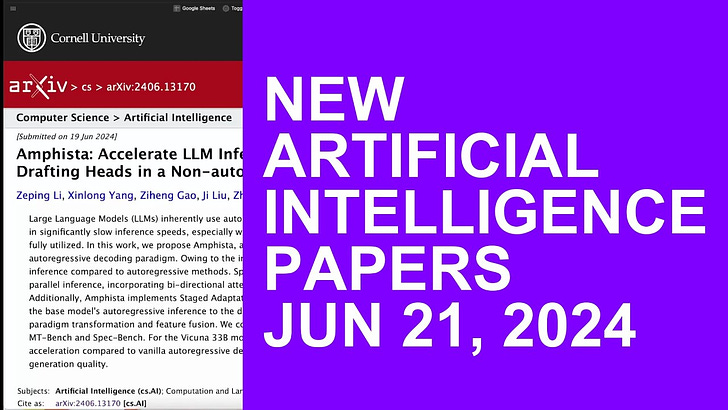
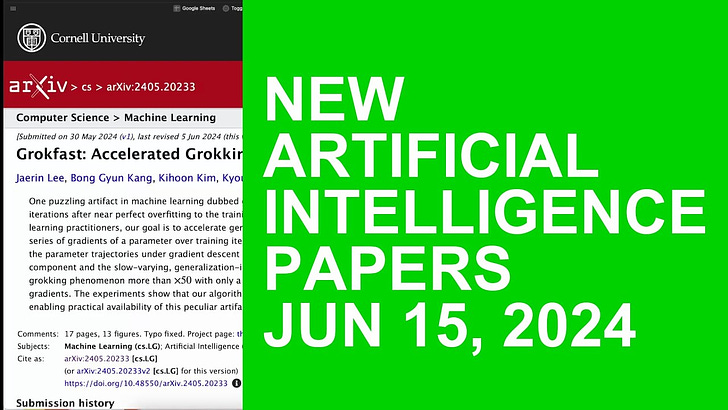
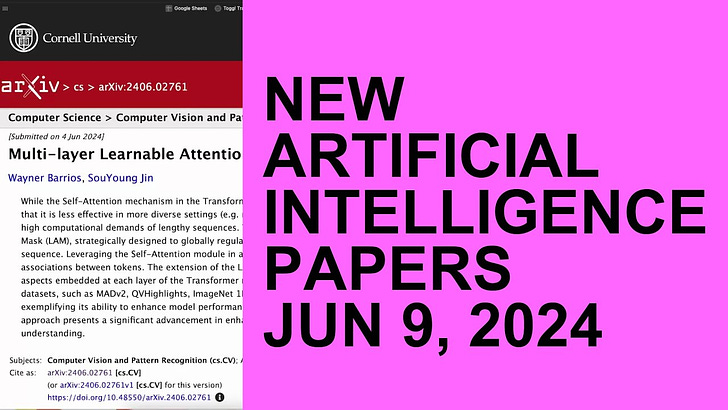
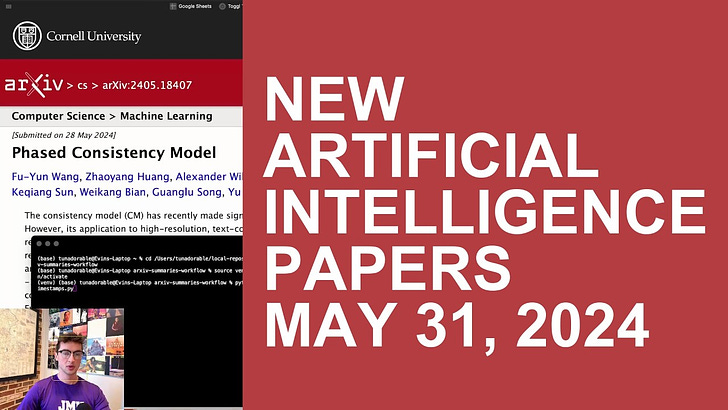
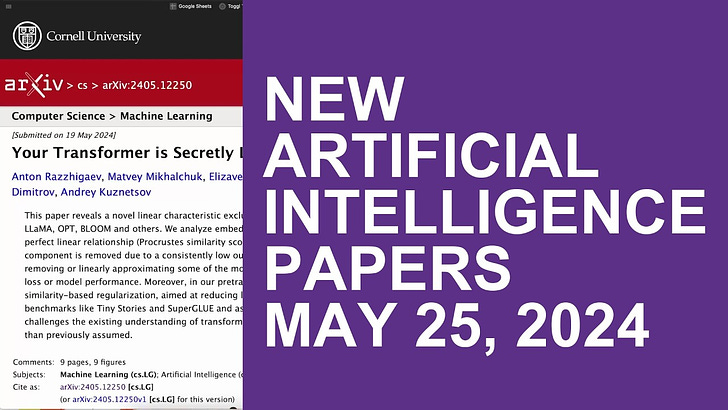
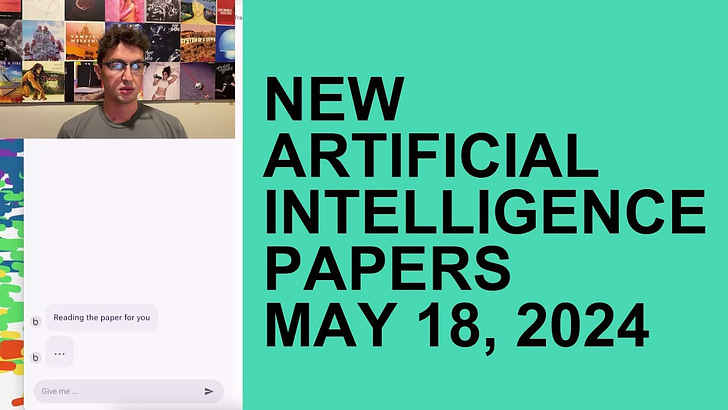
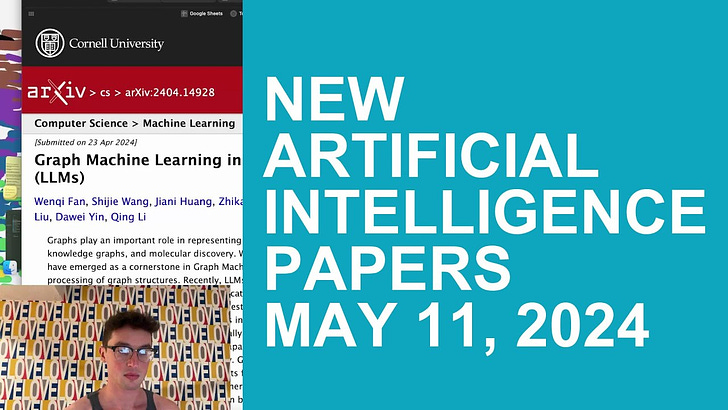
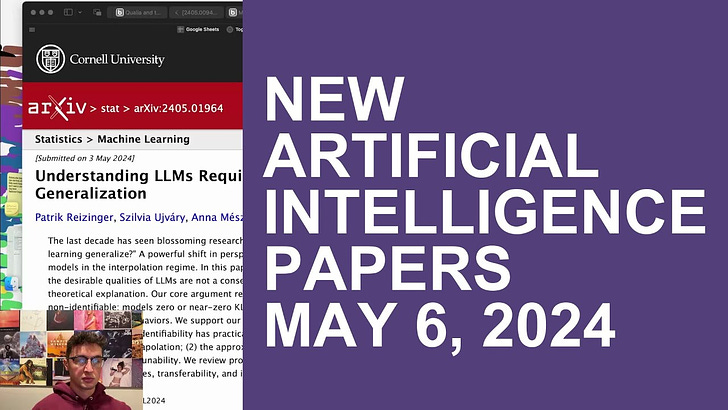
This Week's AI Papers - April 26, 2024